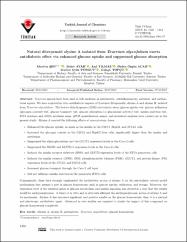| dc.contributor.author | Sen, Alaattin | |
| dc.contributor.author | Ayar, Buket | |
| dc.contributor.author | Yilmaz, Anil | |
| dc.contributor.author | Acar, Ozden Ozgun | |
| dc.contributor.author | Turgut, Gurbet Celik | |
| dc.contributor.author | Topcu, Gulacti | |
| dc.date.accessioned | 2020-02-03T07:45:49Z | |
| dc.date.available | 2020-02-03T07:45:49Z | |
| dc.date.issued | 2019 | en_US |
| dc.identifier.issn | 1300-0527 | |
| dc.identifier.other | 10.3906/kim-1904-57 | |
| dc.identifier.uri | https://hdl.handle.net/20.500.12573/94 | |
| dc.description | This work was supported by the Scientific and Technological Research Council of Turkey under TUBITAK, under Project No.: 114Z640, and Pamukkale University under Project No.: PAUBAP-2014FBE029. | en_US |
| dc.description.abstract | Teucrium species have been used in folk medicine as antidiabetic, antiinflammatory, antiulcer, and antibacterial agents. We have explored in vitro antidiabetic impacts of 2 natural diterpenoids, alysine A and alysine B, isolated from Teucrium alyssifolium. The lactate dehydrogenase (LDH) cytotoxicity assay, glucose uptake test, glucose utilization (glycogen content) test, glucose transport test, glucose absorption (a-glucosidase activity) test, insulin secretion test, RNA isolation and cDNA synthesis assay, qPCR quantification assays, and statistical analyses were carried out in the present study. Alysine A exerted the following effects at non-cytotoxic doses: Enhanced the glucose uptake, as much as the insulin in the C2C12, HepG2, and 3T3-L1 cells Increased the glycogen content in the C2C12 and HepG2 liver cells, significantly higher than the insulin and metformin Suppressed the alpha-glucosidase and the GLUT2 expression levels in the Caco-2 cells Suppressed the SGLT1 and GLUT1-5 expression levels in the Caco-2 cells Induced the insulin receptor substrate (IRS)1 and GLUT2 expression levels of the BTC6 pancreatic cells Induced the insulin receptor (INSR), IRS2, phosphoinositide 3-kinase (PI3K), GLUT4, and protein kinase (PK) expression levels of the 3T3-L1 and C2C12 cells Increased glucose transport through the Caco-2 cell layer Did not influence insulin secretion in the pancreatic BTC6 cells Consequently, these data strongly emphasized the antidiabetic action of alysine A on the particularly critical model mechanisms that assume a part in glucose homeostasis, such as glucose uptake, utilization, and storage. Moreover, the expression level of the essential genes in glucose metabolism and insulin signaling was altered in a way that the results would be antihyperglycemic. A blend of in vitro and in situ tests affirmed the antihyperglycemic action of alysine A and its mechanism. Alysine A has exercised significant and positive results on the glucose homeostasis; thus, it is a natural and pleiotropic antidiabetic agent. Advanced in vivo studies are required to clarify the impact of this compound on glucose homeostasis completely. | en_US |
| dc.description.sponsorship | Scientific and Technological Research Council of Turkey under TUBITAK 114Z640 Pamukkale University PAUBAP-2014FBE029 | en_US |
| dc.language.iso | eng | en_US |
| dc.publisher | SCIENTIFIC TECHNICAL RESEARCH COUNCIL TURKEY-TUBITAK, ATATURK BULVARI NO 221, KAVAKLIDERE, TR-06100 ANKARA, TURKEY | en_US |
| dc.relation.ispartofseries | 43; | |
| dc.rights | info:eu-repo/semantics/openAccess | en_US |
| dc.subject | Alysine A | en_US |
| dc.subject | alysine B | en_US |
| dc.subject | antidiabetic | en_US |
| dc.subject | ; Teucrium alyssifolium | en_US |
| dc.subject | glucose homeostasis | en_US |
| dc.title | Natural diterpenoid alysine A isolated from Teucrium alyssifolium exerts antidiabetic effect via enhanced glucose uptake and suppressed glucose absorption | en_US |
| dc.type | article | en_US |
| dc.contributor.department | AGÜ, Yaşam ve Doğa Bilimleri Fakültesi, Moleküler Biyoloji ve Genetik Bölümü | en_US |
| dc.contributor.institutionauthor | | |
| dc.identifier.doi | 10.3906/kim-1904-57 | |
| dc.relation.publicationcategory | Makale - Uluslararası Hakemli Dergi - Kurum Öğretim Elemanı | en_US |


















